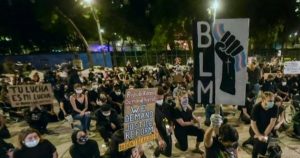Black, Latino and Pacific Islander residents of Los Angeles County are twice as likely to have died from infection by the coronavirus, according to new data, a troubling sign of the role racism and inequity have played in the uneven spread of COVID-19.
For the first time in L.A. County’s weekly tracking, the death rate per 100,000 people among Latinos is now double that of white people, according to data released by county officials Friday.
White residents of L.A. County were the least likely racial and ethnic group to die from the virus, with 15 fatalities reported per 100,000 Caucasian residents.
Officials estimated that if minorities were dying at the same rate as whites, there would have been more than 700 fewer deaths in L.A. County. As of Tuesday, there had been 2,656 coronavirus-related deaths in the county.
Advertisement
“The very real impact of the injustices plays out every day … and amplifies why racism is a public health issue,” Dr. Barbara Ferrer, Los Angeles County public health director, said. “And the disproportionately higher number of deaths from COVID-19 among black and brown people is an indication of the impact of racism and discrimination on health and well-being.
“These numbers are absolutely devastating and represent real people whose lives have been lost,” Ferrer said. “They also starkly show how inequities have a life-and-death consequence.
“We shouldn’t see these big differences,” she added.
For every 100,000 black residents, there have been 31 coronavirus deaths.
Advertisement
For every 100,000 Native Hawaiian/Pacific Islander residents, there were 30 coronavirus deaths.
For every 100,000 Latino residents, there were 29 coronavirus deaths.
And for every 100,000 Asian American residents, there were 21 coronavirus deaths.
The disparity in the death toll is also striking when factoring in community poverty levels.
Advertisement
Those living in poor areas have four times the rate of death
Those living in areas with high rates of poverty have almost four times the rate of death for COVID-19, the disease caused by the coronavirus, Ferrer said.
For every 100,000 residents who live in areas with very low poverty rates, 13 have died.
But for every 100,000 residents who live in areas with high rates of poverty, 51 have died.
Advertisement
It is helpful to analyze death rates per 100,000 people in each race and ethnic group as well as with economic factors, Ferrer said, because it allows scientists and public policy experts to make comparisons with other groups.
‘A disturbing picture’ of excess deaths among minorities
L.A. County officials also calculated the numbers in a different way: How many more minorities died because they didn’t have the health advantages white people have?
When there are big differences in health outcome by race, ethnicity or where you live, public health scientists know that “what they’re reflecting is the result of not having access to resources and opportunities that really contribute to optimal health,” Ferrer said.
Advertisement
So health experts can calculate a number of excess deaths among groups of people that “didn’t have the advantage of being in that reference group — whichever group does the best,” Ferrer said.
And so when county scientists looked at excess deaths linked to the coronavirus by race, ethnicity and income, “it paints a disturbing picture,” Ferrer said.
“If the coronavirus death rate for all groups were the same as it is for white residents — who have the lowest death rate — we would have 754 fewer deaths,” Ferrer said, of the 2,373 people who have died in L.A. County where race and ethnicity information was available.
Advertisement
This means that, because of the disproportionate effect the coronavirus is having on these racial and ethnic groups compared with white people, there were:
- Among Latinos, 485 excess deaths
- Among blacks, 143 excess deaths
- Among Asian Americans, 125 excess deaths
And when experts look at communities by income, and assume that death rates for all groups could be the same as it is for people living in wealthier areas, they found:
- Among people living in areas with higher levels of poverty, 981 excess deaths
Advertisement
Health disparities for minorities start ‘at the beginning of life’
There are higher rates of death and disability for almost every community of color, Ferrer said.
“It starts at the beginning of life: When black babies are three to four times more likely to die before they reach their first birthday; and at the very end of life, when black residents die, on average, six to 10 years younger than all others,” Ferrer said.
“We must look at the structure, systems and practices in our society to understand the root cause of these inequities, which really have much to do with a long history of institutional racism. And that’s resulted in — and continues to result in — fewer resources and opportunities that are needed for optimal health and well-being,” Ferrer said. She thanked “everyone who’s been on the front lines for this last week, standing to end racism and oppression.”
Advertisement
Health disparities that have led black people to be sicker and caused them to die younger than white people have persisted since the founding of the United States, Dr. Mary Bassett, a former health commissioner for New York City and professor of Harvard’s T.H. Chan School of Public Health, said recently.
Dr. Christina Ghaly, director of health services of L.A. County, agreed that the disproportionate impact of the coronavirus on minorities “is due to the long-standing structural and systemic racism that is apparent in multiple aspects of our society.”
Increasing testing in minority neighborhoods
She said the county is focused on trying to ramp up testing sites in areas that especially need it, and connect those who are found to be positive with clinical care. One county testing site at the Charles R. Drew University of Medicine and Science in Willowbrook, south of Watts, is staffed by workers from the Martin Luther King Jr. Outpatient Center and connects people with the outpatient center or other clinics.
Advertisement
Ghaly said staff at Charles Drew University are trying to reach out to the community to encourage testing, canvassing local grocery stores and community-based organizations, a practice she credits with increasing daily testing from about 150 to more than 700.
“This is a model that we’re very proud of and that we can follow a successful community-based approach to testing and outreach,” Ghaly said. She said the county plans to apply for a $4-million grant to the U.S. Centers for Disease Control and Prevention to help fund communications campaigns in hard-hit communities and among non-English speakers.
One sign of promise, Ghaly said, is that communities of color are accessing drive-through testing sites in a manner proportionate to the overall population.
“But given how the death and case rate is disproportionately falling on these at-risk communities, we need to do more,” she said.
Advertisement
Experts have been worried about the brief closure of many government-run testing sites throughout L.A. County. Half of the approximately 40 facilities were shut down at some point in the last week amid protests demonstrating against the death of George Floyd while in police custody in Minneapolis.
Ghaly said each testing site made its own choice whether to close or reduce hours. Volume of testing declined slightly last week, Ghaly said, in some cases related to closures, in others due to prospective patients not showing up or canceling amid concerns about demonstrations or curfews.
Here are the percentages of L.A. County residents who have died, by race and ethnicity, as of Friday, from COVID-19, for the 2,373 people for which officials have race and ethnicity data:
Latino: 41%
White: 28%
Asian: 18%
Black: 12%
Native Hawaiian/Pacific Islander: Less than 1%
Other: 1%
Advertisement
For comparison, here are the percentages of L.A. County residents by race and ethnicity:
Latino: 49.3%
White: 27.6%
Asian American: 14.5%
Black: 8.2%
Native Hawaiian/Pacific Islander: 0.2%
A Los Angeles Times analysis published last month found that while the early weeks of the pandemic in L.A. County suggested infection rates were greater in wealthier communities, it was in mid-April that infection rates in poor communities began to overtake wealthier ones.
The analysis found infection rates across South and Central Los Angeles and the Eastside have increased sharply and now lead all regions in the county, exceeding 600 infections per 100,000 people, the analysis shows.
Advertisement
Poorer areas such as Pico-Union and Westlake in Central L.A., and Vermont Square in South L.A., all reported low infection rates in early April, but now rank among the top 10 communities out of more than 300 countywide.
The analysis found that areas hit hardest by the coronavirus are largely concentrated in the poorest, most crowded neighborhoods — areas with a lot of essential workers, more crowded housing and higher rates of underlying health conditions such as asthma, diabetes and heart disease.
Times staff writers Tony Barboza, Soumya Karlamangla, Ryan Menezes, Deborah Netburn and Ben Poston contributed to this report.


















